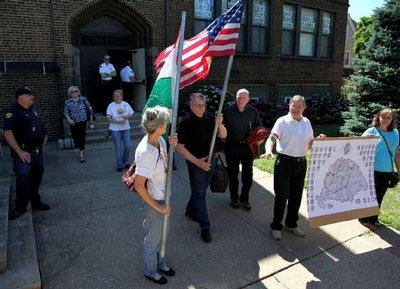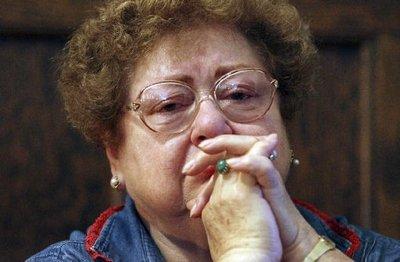By Meghan Barr
Journal Gazette
July 4, 2010
http://www.journalgazette.net/article/20100704/NEWS11/307049885/1002/LOCAL
CLEVELAND – A bell tolled solemnly as a man read the names of the fallen churches like a list of dearly departed saints.
St. Hedwig's, recently sold to a drug rehabilitation agency. St. Andrew's, demolished months ago.
Now joining them is St. Emeric's, an old Hungarian parish, where about 100 parishioners gathered Wednesday to say goodbye. The church is the last of 50 parishes to close its doors, ending a massive downsizing of mostly older, ethnic parishes decreed by the Roman Catholic Diocese of Cleveland because of falling attendance, a priest shortage and financial problems.
"I'm brokenhearted," said Madeleine Smith, a lifelong parishioner at St. Emeric's. "My parents were married here. My grandparents were members before the church was built."
The diocese has said many of the churches were operating in the red. Some were closed while others merged.
Roman Catholic dioceses across the country have been struggling for years to maintain aging churches amid declining parishioners and financial problems exacerbated by the clergy sex abuse scandal.
Before entering St. Emeric's for the last time, the faithful gathered outside to sing Hungarian hymns and criticize Bishop Richard Lennon, who has overseen the closings.
 |
| Under the eye of police, parishioners at St. Emeric’s Catholic Church in Cleveland end a 16-hour sit-in at the church last week, an unsuccessful attempt to keep it open |
"We have done all in our power to keep our churches open," said Bob Kloos, vice president of Endangered Catholics, a local group that has tried to fight the closings. "And we witness the unacceptable loss of yet another vibrant, ethnic treasure."
In Cleveland, where residents for years have fled the city limits for the suburbs, the crisis of the Catholic church closings mirrors the slow decay of the inner city. The spires of old churches rise above abandoned buildings, vestiges of the Eastern European immigrants who settled in the city during the Industrial Revolution. In the early 1900s, the churches were often built by the parishioners, who pieced together every brick and pane of stained glass.
Back then, the church was the social center of the community. Not so anymore. Fewer than 50 people sometimes attended Mass on recent Sundays.
But parishioner Ildiko Korossy, who was married at St. Emeric's 45 years ago, said the church has more than enough parishioners and has been well-maintained.
"We are not short of money," she said. "We have never, in the history of our church, ever borrowed any money from the diocese."
St. Emeric's is one of two Hungarian parishes to close, leaving just one to serve Cleveland's Hungarian community. The diocese says that's enough.
"If you piece the three Hungarian parishes together into one, you might have 1,200 households, which is well below what even our smallest average is in the city, about 2,500," diocese spokesman Robert Tayek said.
The churches primarily serving Cleveland's ethnic groups, which include the Polish, Hungarians and Slovenians, claim that they are being unfairly targeted by the diocese. Amid rising anger from parishioners, Lennon has canceled plans for some farewell Masses and warned congregations not to set up "renegade" churches. When the bishop does attend Mass, he generally is escorted by police.
Lennon, who became bishop of Cleveland in 2006 after overseeing church closings in Boston, is viewed by many Catholics as an outsider who was brought in solely to shut down churches. Endangered Catholics has demanded the appointment of a bishop to oversee Lennon's work.
In a statement released to The Associated Press, Lennon said the downsizing represents just one aspect of the church's Vibrant Parish Life initiative, which began 10 years ago.
 |
| Irma Friedrich, a parishioner at St. Emeric’s, cries during a prayer service Wednesday as the church closed its doors. |
"Now, we must encourage all the faithful to promote worship as the center of our lives," he wrote.
When a church closes, the diocese dismantles the interior and removes sacred artifacts, such as stained glass, chalices and the altar. Then the pieces are taken to a warehouse run by Henninger's, a local religious goods store that appraises them and puts them up for sale. Some items are handed over to other parishes within the diocese, but others are sold to church institutions, including a group of nuns from Kentucky who recently hauled off an altar in a rental truck.
Before the downsizing began, the Cleveland diocese had 224 parishes serving about 766,000 Catholics in eight northeast Ohio counties. Now there are 174 parishes left.
As the protest drew to a close, parishioners sang "God Bless America" and cheered as a plane flew overhead carrying a banner that read: "Jesus Is Lord. Viva Hungarians."
Any original material on these pages is copyright © BishopAccountability.org 2004. Reproduce freely with attribution.